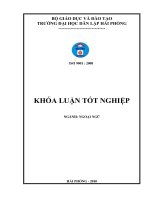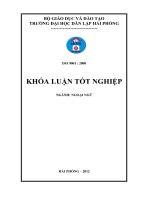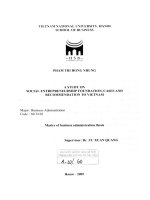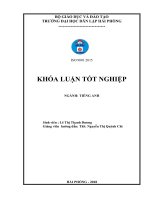A STUDY ON UNREAL CONDITIONAL SENTENCES AND WAYS TO TRASLATE THEM INTO VIETNAMESE
Bạn đang xem bản rút gọn của tài liệu. Xem và tải ngay bản đầy đủ của tài liệu tại đây (371.69 KB, 65 trang )
BỘ GIÁO DỤC VÀ ĐÀO TẠO
TRƯỜNG ĐẠI HỌC DÂN LẬP HẢI PHỊNG
-------------------------------
ISO 9001 : 2008
KHĨA LUẬN TỐT NGHIỆP
NGÀNH: NGOẠI NGỮ
HẢI PHÒNG - 2010
HAIPHONG PRIVATE UNIVESITY
FOREIGN LANGUAGES DEPARTMENT
-----------------------------------
GRADUATION PAPER
A STUDY ON UNREAL CONDITIONAL SENTENCES
AND WAYS TO TRASLATE THEM INTO
VIETNAMESE
By:
PHẠM THỊ LÀNH
Class:
NA1004
Supervisor:
CHU THỊ MINH HẰNG, M.A
HAI PHONG - 2010
BỘ GIÁO DỤC VÀ ĐÀO TẠO
TRƯỜNG ĐẠI HỌC DÂN LẬP HẢI PHÒNG
--------------------------------------
Nhiệm vụ đề tài tốt nghiệp
Sinh viên: ............................................................Mã số: ............................
Lớp: .............................Ngành:....................................................................
Tên đề tài: .................................................................................................
..................................................................................................
.................................................................................................
..................................................................................................
Nhiệm vụ đề tài
1. Nội dung và các yêu cầu cần giải quyết trong nhiệm vụ đề tài tốt nghiệp
( về lý luận, thực tiễn, các số liệu cần tính toán và các bản vẽ).
……………………………………………………………………………..
……………………………………………………………………………..
……………………………………………………………………………..
……………………………………………………………………………..
……………………………………………………………………………..
……………………………………………………………………………..
……………………………………………………………………………..
……………………………………………………………………………..
2. Các số liệu cần thiết để thiết kế, tính tốn.
……………………………………………………………………………..
……………………………………………………………………………..
……………………………………………………………………………..
……………………………………………………………………………..
……………………………………………………………………………..
……………………………………………………………………………..
……………………………………………………………………………..
……………………………………………………………………………..
……………………………………………………………………………..
3. Địa điểm thực tập tốt nghiệp.
……………………………………………………………………………..
……………………………………………………………………………..
……………………………………………………………………………..
CÁN BỘ HƯỚNG DẪN ĐỀ TÀI
Người hướng dẫn thứ nhất:
Họ và tên: .............................................................................................
Học hàm, học vị: ...................................................................................
Cơ quan công tác:.................................................................................
Nội dung hướng dẫn:............................................................................
Người hướng dẫn thứ hai:
Họ và tên:.............................................................................................
Học hàm, học vị:...................................................................................
Cơ quan công tác:.................................................................................
Nội dung hướng dẫn:............................................................................
Đề tài tốt nghiệp được giao ngày 12 tháng 04 năm 2010
Yêu cầu phải hoàn thành xong trước ngày 10 tháng 07 năm 2010
Đã nhận nhiệm vụ ĐTTN
Sinh viên
Đã giao nhiệm vụ ĐTTN
Người hướng dẫn
Hải Phòng, ngày tháng năm 2010
HIỆU TRƯỞNG
GS.TS.NGƯT Trần Hữu Nghị
PHẦN NHẬN XÉT TÓM TẮT CỦA CÁN BỘ HƯỚNG DẪN
1. Tinh thần thái độ của sinh viên trong quá trình làm đề tài tốt nghiệp:
……………………………………………………………………………..
……………………………………………………………………………..
……………………………………………………………………………..
……………………………………………………………………………..
……………………………………………………………………………..
……………………………………………………………………………..
……………………………………………………………………………..
……………………………………………………………………………..
2. Đánh giá chất lượng của khóa luận (so với nội dung yêu cầu đã đề ra trong
nhiệm vụ Đ.T. T.N trên các mặt lý luận, thực tiễn, tính tốn số liệu…):
……………………………………………………………………………..
……………………………………………………………………………..
……………………………………………………………………………..
……………………………………………………………………………..
……………………………………………………………………………..
……………………………………………………………………………..
……………………………………………………………………………..
……………………………………………………………………………..
……………………………………………………………………………..
3. Cho điểm của cán bộ hướng dẫn (ghi bằng cả số và chữ):
……………………………………………………………………………..
……………………………………………………………………………..
……………………………………………………………………………..
Hải Phòng, ngày ….. tháng ..… năm 2010
Cán bộ hướng dẫn
(họ tên và chữ ký)
NHẬN XÉT ĐÁNH GIÁ
CỦA NGƯỜI CHẤM PHẢN BIỆN ĐỀ TÀI TỐT NGHIỆP
1. Đánh giá chất lượng đề tài tốt nghiệp về các mặt thu thập và phân tích tài liệu,
số liệu ban đầu, giá trị lí luận và thực tiễn của đề tài.
2. Cho điểm của người chấm phản biện :
(Điểm ghi bằng số và chữ)
Ngày.......... tháng......... năm 2010
Người chấm phản biện
ACKNOWLEDGMENTS
During the course of fulfilling my graduation paper, I have owned a debt of gratitude to
many people.
First, and foremost, I would like to express my deepest to gratitude to Ms Chu Thi Minh
Hang M.A, my supervisor, for her enlightening guidance, without which the research paper
could be completed.
Second, my special thanks would be sent to all lecturers of Foreign language Department
of Hai phong Private University for their valuable comments and assistance.
Last, but not least, I am deeply grateful to my family and friends for their spiritual and material
assistance during the time this study was carried out.
ABBREVIATION
Dep Cl
Dependent clause
Indep Cl
Independent clause
Conj
Conjunction
SL
Source language
TL
Target language
ST
Source text
TT
Target Text
TABLE OF CONTENTS
PART I
INTRODUCTION ………………………………………
1. Rationales ...............................................................................................
2. The aims of the study .............................................................................
3. The scopes of the study ...........................................................................
4. Methods of the study ..............................................................................
5. The design of the study ..........................................................................
PART II
DEVELOPMENT ……………………………………….
CHAPTER I: GENERALIZATION ABOUT CONDITONALS IN ENGLISH
I. Sentences ………………………………………………………………….
1.Definition of sentences …………………………………………………….
2. Classification of sentence …………………………………………………
2.1 Simple sentence ………………………………………………………….
2.2 Compound sentence ……………………………………………………..
2.3 Complex sentence ……………………………………………………….
2.4 Compound – complex sentence …………………………………………
II. Conditionals sentences …………………………………………………
1. Definition of conditional sentences……………………………………….
2. Classification of conditionals …………………………………………….
2.1 Real conditionals ………………………………………………………..
2.1.1 Zero conditionals ……………………………………………………..
2.1.2 First conditionals ……………………………………………………..
2.2 Unreal conditionals
2.2.1 Unreal conditionals in the present
a. Definition
b. Form
c. Use
d. Variations of second conditional sentences
2.2.2 Unreal conditionals in the past
a. Definition
b. Form
c. Use
d. Variations of third conditional sentences
2.2.3 Mixed conditionals
a. Definition
b. Form
c. Use
2.3 Implied conditionals
2.4 Short conditionals
2.5 Conditional inversions
2.6 Other conditional words and structures other than "if"
2.6.1. Using other conditional conjunctions
2.6.2. Using different structure
CHAPTER II: BACKGROUND ON TRANSLATION
I. Definition of translation
II. Methods of translation
III. Comments in two methods: Semantic and Communicative translation
CHAPTER 3: WAYS TO TRANSLATE UNREAL CONDITIONALS
INTO VIETNAMESE
I. Translation of unreal conditionals in the present.
II. Translation of unreal conditionals in the past.
III. Translation of Conditional inversions
IV. Translation of Mixed conditionals
V. Translation of Implied conditionals
VI. Translation of Implied conditionals
VII. Translation of other conditional words and structures other than “if”.
1. Translation of other conditional words
2. Translation of other structures
PART III
REFERENCE
CONCLUSION
PART I
INTRODUCTION
1. Rationale
To many Vietnamese learners who have been learning English for a long
time, English grammar still seems to be a puzzle. Among a number of complex
problems, conditional sentences are really a challenge. They are difficult because
of their complicated structures with two clauses: subordinate clause or if-clause
and main clause. In addition, there are many variations which may cause
confusion. The meanings of conditional sentences are subtle; therefore in order to
understand them, we need to be sensitive enough. Moreover, any conditional
sentence is a combination of tense and a range of auxiliaries which require learners
to grasp before being able to understand and use it.
Furthermore, conditional sentences represent an obstacle to Vietnamese
learners in the English-Vietnamese translation process. There are a large number of
problems they may have while translating these conditional sentences, especially
unreal conditional ones into Vietnamese. They may produce worse or even wrong
version to the original one, as many students do not really have full understanding
of unreal conditionals. In order to correctly and satisfactorily translate them into
Vietnamese, it is worth studying their definitions, types and characteristics. Also,
students should look into techniques of translation by examining unreal conditional
sentences translated by famous practitioners. Since they are such high barriers to
learners, I find it necessary to discuss the topic "Unreal conditionals and ways to
translate them into Vietnamese" in my paper.
2. The aims of the study
The aims of this study are:
- Categorizing English conditionals to help the readers have an insight into
English conditionals especially unreal conditionals which may cause confusion to
many learners of English.
- Introducing some common translating methods which may be helpful in
translating unreal conditionals.
- Suggesting some practical ways to translate English unreal conditionals into
Vietnamese equivalents.
3. The scopes of the study
Due to the time limitation, it doesn't have the ambition to cover all details
related to the conditionals. This study, therefore, mainly focuses on the features
and uses of the most striking cases of conditional structures in English. And the
study also concentrates on ways of translating unreal conditional structures and
sentences, which often cause troubles or mistakes to both Vietnamese translators
and interpreters.
4. Methods of the study
- Analyzing available translation materials in published books and novels.
- Consulting experienced people such as my supervisor, my teachers and
friends on the matter concerned.
- Relying on my observation and experience during my learning process.
5. The design of the study
This study is divided into 3 chapters:
Chapter 1 presents the definitions, elements and types of sentences. It also
gives the readers a generalization about conditionals, especially unreal
conditionals.
Chapter 2 attempts to present an overview of basic theoretical translation as
well as the two methods which are helpful in translating unreal conditionals.
Chapter 3 gives some ways to translate unreal conditionals and sentences
with other words and structures other than “if” into Vietnamese.
PART II
DEVELOPMENT
CHAPTER 1: GENERALIZATION ABOUT CONDITONALS
IN ENGLISH
To have an insight into conditionals, I would like to present the basic
knowledge of sentences including definition and types of sentences as well as
unreal conditionals.
I. Sentences
1. Definitions of sentences
There are a number of sentence definitions given by different grammarians.
According to L.G. Alexander (1988:2), a sentence is defined as “a complete unit of
meaning. When we speak, our sentence may be extremely involved or even
unfinished, yet we can still convey our meaning through intonation gesture, facial
expression, etc. When we write, these devices are not available, so sentences have
to be carefully structured and punctuated. A written sentence must begin with a
capital letter and end with a full stop (.), a question mark (?) or an explanation
mark (!)"
Roloff and Brosseit in the book “Sentences” (1979:13) writes "sentence is a
group of related words that expresses a complete and meaningful thought; either a
statement, a question, a command or an exclamation".
In addition, the "New Webster's expanded dictionary" states, "Sentence is an
opinion, a maxim, a judgment, a number of words containing complete sense"
In short, a sentence is a group of words that you use to communicate ideas in
writing or in speaking. Every sentence is composed of one or more clauses and
expresses a complete thought.
According to Randolph Quirk and Sidney Greenbaum (1987:12), a sentence
may alternatively be seen as comprising five units called elements of structure:
subject, verb, complement, object, adverbial abbreviated respectively as S, V, C,O,
A.
2. Classification of sentences
2.1 Simple sentence
A simple sentence is the one that consists of one clause. We have seven
clause types, or in other words, seven patterns of simple sentences (Quirk,
1987:165)
* SV
The child laughed.
* SVA
Mary is in the house.
* SVC
Mary is kind/ a nurse.
* SVO
Somebody caught the ball.
* SVOA
I put the bag on the table.
* SVOC
We have proved him wrong/ a fool.
* SVOO
She gives me expensive presents.
2.2 Compound sentence
A compound sentence is the one that contains two or more independent
clauses, usually liked together by a coordinating conjunction.
* Mary sang, and John danced.
Indep Cl
Conj Indep Cl
2.3 Complex sentence
A complex sentence is the one that contains an independent clause and one
or more dependent clauses.
. After he had finished his homework, he went out with his girlfriend.
Dep Cl
Indep Cl
Dependent clauses may be classified by structural type, i.e. in terms of the
element, or by function, i.e. the part they play in the subordinate clause.
* Analyzing by structural type, we have:
- Finite clause: A clause whose verb element is a finite verb phrase.
. Tom is very tired because he has worked for a long time.
- Non - finite clause: A clause whose verb element is a non finite verb
phrase.
. Having seen the pictures, he....
- Verbless clause: A clause containing no verb element.
. Al though always busy, he comes to see me once a day.
* Functional classification of dependent clauses: Dependent clauses may
function as subject, object, complement or adverbial in the superordinate clause.
- Nominal clauses:
+ Subject: That we need more equipment is obvious.
+ Direct object: I know that she is pretty.
+ Indirect object: I gave whoever it was a cup of coffee.
+ Object complement: I imagined him overcome with grief.
- Adverbial clauses:
+ Adjunct: When we meet, I shall explain everything.
+ Disjunct: To be honest, I have never loved her.
+ Conjunct: What is more, he has lost the friends he had.
In general, subordination is marked by some indications. Such a signal may
be of the following different kinds.
- Subordinators:
Simple subordinators: after, (al) though, as, because, before, if, once, since,
that, until, when, where, while...
Compound subordinators:
. Ending with “that”: in that, so that, such that, except that...
. Ending with optional “that”: now (that) provided (that), supposing (that),
considering (that)...
. Ending with “as”: as far as, as long as, as soon as, so long as...
. Ending with “than”: sooner than (+ infinitive clause), rather than (+ non
finite or verb less clause)
. Other: as though, as if, in case...
Correlative subordinators: If... then, Al (though)... yet/ nevertheless, as ....so,
such....as, no sooner....than, whether....or, the....the, such.....that...
. This is such a good film that I have watched it several times.
-Other indicators of subordination
Wh-elements: Who, whom, whose, which, where, when, whether, how,
what, why, whoever, whatever, wherever, whenever...
Subject-operator inversion: It is a marker of subordination in some
conditional clauses, where the operator is had, were, or should.
. Had I known before, I would have helped him.
Other unusual syntactic orderings also play a role in distinguishing a
subordinate clause: e.g. Sad though I was.
The relative pronoun that (to be distinguished from the subordinating
conjunction that) is a subordination marker in relative clauses:
E.g. The bus that took me there was late.
The absence of a finite verb form is effectively an indication of subordinate
status, since non – finite and verbless clauses occur only in independent clauses:
E.g. The match will take place tomorrow, weather permitting.
There are only two types of subordinate clause that contain no marker within
themselves of subordinate status: these are
(I)Nominal clause which may or may not have that
I suppose you’re right (I suppose that you’re right).
(II) Comment clauses of a kind relatable to the main clause in the previous
example:
You’re right, I suppose
In short, from the theory above, we can recognise that conditional sentences are
under the group of complex sentences because conditionals include one “if clause”
(subordinate or dependent clause) and one main clause (independent clause).
3.4 Compound complex sentence
A compound complex sentence is a combination of two or more independent
clauses and one or more dependent clauses.
It is like a family of two adults and one or more children.
Example:
. After I graduated from high school, I wanted to travel, but I had to
Dep Cl
Indep Cl
Dep Cl
work in my family's business.
II. Conditional sentences
1. Definition of conditional sentences
Much effort has been devoted to finding a clear definition of English
conditional sentences. In fact, conditional sentences are defined in many different
ways by different linguists. One of them is "the dependence of one set of
circumstance (i.e. the result clause) on another (i.e. the if-clause)" (Quirk and
Greenbaum, 1987:323). In other words, the conditionals present "a grammatical
relationship" in which one situation is said to be dependent on another (Tom
McArthur, 1972).
Collins Cobuild - English grammar (1992) looks into conditional sentences
in terms of the structure as it claims that a conditional sentence includes two
components. The subordinate clause, usually beginning with "if", gives a condition
that must be fulfilled before what the main clause says can be true, possible, or
done.
By the same token, its structure is also examined as follows: the if- clause or
"the protasis" expressing a condition and the main clause or "the apodosis" stating the
reason. (Oxford English Dictionary Volume II C, 1979)
Briefly, conditional sentences, in terms of structure, are made up of two
clauses: the “if” clause also “subordinates", "dependent clause" or “protasis" and
by “the main clause” or "apodosis". In normal, the dependent clause is followed by
“the main clause”, but sometimes the “if clause” stands before “the main clause”.
For examples:
Eg:
I would buy this car, if I were you.
If it rains, I will stay at home.
There is a close interrelationship between the two elements. The if- clause
often refers to a condition which must take place first so that something else can
happen in the main clause.
2. Classification of conditional sentences
2.1 Real conditionals
2.1.1 Zero conditionals
Zero conditionals are for situations that are always true. They are often used
in scientific writing.
If clause,
Main clause
Present tense
Present tense
If the temperature drops below 00C, water freezes.
2.1.2 First conditionals
First conditional sentences make predictions about what will happen in
future. It “implies the action in the if-clause is quite probable” (Thomas and
Martinet, 1985:197).
If clause,
Main clause
Present tense
Future tense
If he catches
the fast train, he will get here early.
2.2 Unreal conditionals
2.2.1. Unreal conditionals in the present
a. Definition
This type is also called second conditionals. It expresses "the action as a
theoretical possibility, something more distant from reality". (Eastwood, 1994:336)
If I had enough money, I would lend him.
This type of conditionals talks about "unreal situations - things that will
probably not happen, situations that are untrue or imaginary" (Swan, 1997:260). In
other words, we are discussing a hypothetical situation which is unlikely or
impossible to become true later or true now.
b. Form
If – clause
main clause
Past tense
Would + bare infinitive
If Phil lived near his mother, he would visit here more often.
I would tell you the answer if I knew what it was.
c. Use
* We use this structure to make a statement about something that is not real
at present but it is possible (hypothetical conditions).
If I won a lot of money, I would take a long holiday. (I do not win now but I
might in the future)
Second conditionals pertain to a present condition that is not being fulfilled
or not real now and never could be real (hypothetical conditions).
If you were eight and a half feet tall, you would be a great basketball player.
(But you are not eight feet ball, so you are not a great basketball player).
If I were you, I would give up smoking.
(But I could never be you).
* We use second conditionals to refer to both the present and the future.
If it were snowing (at this moment), I would drive you home.
If you didn't pass the exam (in the future), would you take it again?
* When we are tentative or less direct, we use second conditionals to be
more polite.
Would it be OK if I brought a friend?
If we went through the town center, it would probably be quiet.
d. Variations of second conditional sentences
Variations in the if - clause
*Sometimes the continuous form is used in the if –clause to discuss
imaginary situations which would not be happening at this very moment.
If the sun were shining, I would go to the beach.
(Unfortunately, it is raining so I can't go).
* "Should", "should happen". "Happened to" used in if- clause may weaken
the possibility of the condition.
If I should have money, I would buy a house
(It is not likely that I will have money)
If you happened to pass a supermarket, perhaps you could yet some eggs.
If he should happen to finish early, he would be at home.
*"Would" may be used but it is very informal and is common in spoken AE.
It would be better if they would tell anybody in advance.
* "Were to" is used in if - clause to make the event more hypothetical on the
statement more tentative and therefore more polite.
If you were to have a few minutes free, I'd really appreciate the opportunity
to pick your brains.
We'd be in real trouble if the boss were to come in now.
* It is noticeable that this structure is not used with stative verb.
If I knew her name, I would tell you.
(Not if I were to know her name...)
From many examples above, we can see that in the if- clause of a second
conditional, "were" is used with all subjects and pronouns.
In fact, "were" is not really the past tense but the subjunctive to voice a
hypothetical situation.
If I were at home, I'd be able to find the information.
When we use "were" in the if - clause, we can invert "were" and the subject
of the clause, and leave out "if" altogether.
Were he really ill, I might feel more sympathetic.
Variations in the main clause
Like in the first conditional sentence where "will" can be substituted by
other modal verbs, "would" in the second conditional also has many substitutions.
If I won lots of money, I might stop working (possibility)
If I were rich, I could help more people (ability).
We shouldn't get to sleep at all if I lived next to that noise.
"Should" is used instead of "would" after "We/I" with the same meaning as
"would".









